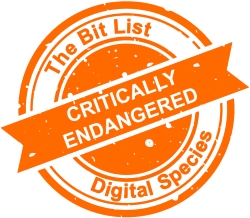Smartphone Apps
 |
||
|
Applications created for smartphones. Many are deprecated quickly but others survive through multiple update cycles. It is hard to maintain version control and is often dependent upon the company that publishes them. There is no clear agency or mandate to record or collect. |
||
|
Digital Species: Apps |
Trend in 2023:
|
Consensus Decision |
|
Added to List: 2017 |
Trend in 2024:
|
Previously: Critically Endangered |
|
Imminence of Action Immediate action necessary. Where detected should be stabilized and reported as a matter of urgency. |
Significance of Loss The loss of tools or services within this group would have a global impact. |
Effort to Preserve | Inevitability Loss seems inevitable: loss has already occurred or is expected to occur before tools or techniques develop. |
|
Examples London 2012 app; BBC Olympic app; apps published for Apple iOS 10 or earlier; apps for less-common operating systems such as Palm OS, Symbian, Blackberry OS. |
||
|
‘Practically Extinct’ in the Presence of Aggravating Conditions Device dependence; poor documentation; uncertainty over IPR or the presence of orphaned works; short-term contracts; lack of skills, commitment or policy from corporate owners; rapid churn of OS; shifting business requirements of app resellers; dependence on exotic or obsolete formats or OS processes. |
||
|
‘Endangered’ in the Presence of Good Practice Strong documentation; version control for code and compiled app; emulation enabled; designated repository taking preservation responsibility and capacity to deliver. |
||
|
2023 Review This entry was added in 2017 to draw attention to the challenges of software preservation and the extraordinary velocity of the market for apps. Given the speed of change, it is hard to see how digital preservation efforts can keep pace. The 2019 Jury noted that splitting this entry into different groups based on the platform would clarify differences, although the risks would be largely the same. The 2021 Jury discussed this further in light of the new 2021 ‘Smartphone Gaming’ entry, which can be considered a subset of this category as well as Gaming in which it is currently assigned. The 2021 Jury found no identifiable trend towards greater or reduced risk but discussed the impact of loss; some loss seems inevitable due to the changes that have taken place in mobile ecosystems over the past 15 years. The 2022 Taskforce noted no change to trend (they agreed these risks remain on the same basis as before with no significant increase or decrease over the preceding year). The 2023 Council agreed with the Critically Endangered classification with no change to trend but also recommended a change to significance of loss; the significance of loss was increased from the previous year’s reviews, suggesting that the loss of tools or services within this group could have a larger global impact. Obsolescence plays a large part; the rate of change of smart operating systems is high, as are the number of apps, which means the obsolescence rate is high. Furthermore, a large number of vendors are also leaving the market, which means their specific apps will also vanish. While the Council agreed the entry description should be updated to reflect these areas of discussion, overall risks remained on the same basis as before (‘No change’ to the 2023 trend). Members of the 2023 Council also noted that it may be better to have a broader smart device apps entry rather than specifically ‘Smartphone Apps’ and ‘Smart TV Apps’ as separate standalone entries. The risks posed by these apps can apply to a variety of devices; for example, before Smartphones, there were PDAs, and there are now Smart fridges, set-top-boxes, fire sticks, e-book readers, and other devices which have apps. For this reason, they recommended that the next major review for the Bit List includes a rescoping of Smartphone Apps and Smart TV Apps to consider: What differentiates these apps from others? What cultural heritage purpose do these apps serve? Are organizations collecting them? Are there distinct aggravating factors or risk profiles? |
||
|
2024 Interim Review These risks remain on the same basis as before, with no significant trend towards even greater or reduced risk (‘No change’ to trend). |
||
|
Additional Comments Old versions of apps are completely lost to most users: once you upgrade an app, you typically cannot go back. Perhaps iOS is more critical - at least with Android, you can often get .apk from the internet separate from the marketplace. The NSRL contains hundreds of thousands of mobile applications which are not being actively preserved but could be if a mandate existed. An extension to Legal Deposit might be possible. The faster we act, the less we will lose. It is unlikely that there will ever be one agent with a mandate to collect different apps available in different countries, so a network of national organizations would be needed. The companies that create these apps are the key to the licensing challenges, and conversation with them is necessary, though it would need to happen immediately in order to negotiate the right to preserve/escrow both apps, operating systems, documentation, and phone development emulators. Messaging apps such as WhatsApp or Telegram have had an increased media presence in the last couple of years due to their role in a number of politics-related issues that have arisen, such as concerns about UK Cabinet Ministers using the auto-delete function which could compromise accountability and transparency of the UK government. Telegram has also gained importance due to its use in the Russia-Ukraine war for sharing news. Case Studies or Examples:
See also:
|
||











































































































































